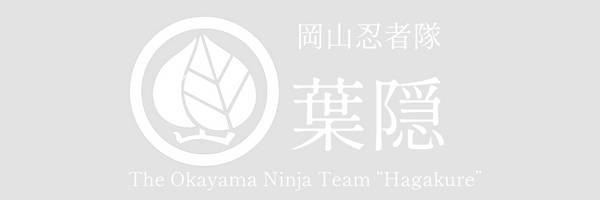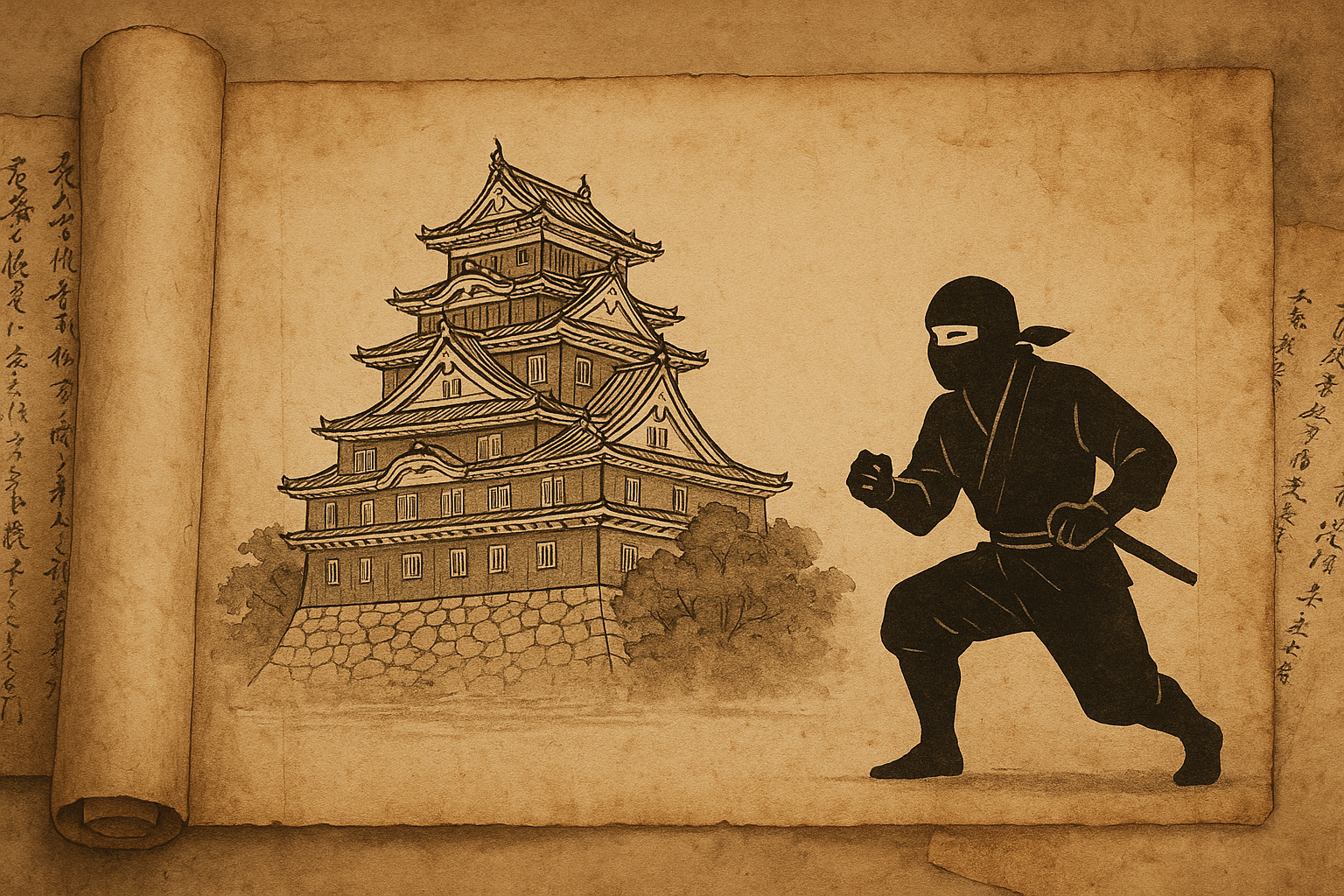宇喜多家と忍者の関係
宇喜多直家の忍術活用
戦国武将・宇喜多直家は、岡山の地に本格的な城を築く前、金光宗高の砦(石山砦)を攻略するために忍者を使ったと伝えられています。
砦に火を放って陥落させたのは、「なまあぜ源六」「西崎おこ右衛門」「小橋かん三兵衛」といった忍びたちでした。
宇喜多秀家と伊賀忍者
直家の子・宇喜多秀家の時代には、伊賀出身の忍者20名が正式に召し抱えられていました。
その頭領は「服部藤内」と呼ばれ、伊賀流の系譜を持つ人物であったと考えられます。
しかし関ヶ原の戦いで秀家が敗れた後、この忍者部隊は解散。服部藤内は岡山近郊の浦間村に移り住み、病死したと伝えられています。
岡山藩と忍者
池田家による伊賀忍者の登用
関ヶ原後、岡山藩主となった池田家も伊賀出身の忍者を召し抱えました。
『池田家文庫』や『作陽誌』には、忍者の実名・役目・俸禄が記録されており、他藩と比較しても詳細なものです。
元和9年(1613年)には61名が在籍していましたが、時代が下るにつれて数は減り、幕末には10名前後に縮小しました。
岡山藩忍者の任務
岡山藩の忍者は多彩な任務を担っていました。
- 諜報活動:他藩や領内の情勢を探索。元禄14年(1701年)には赤穂浪士の動向を調査。
- 治安維持:火災・盗賊の監視、城下町の夜間巡回。
- 藩主護衛:参勤交代や湯治に随行し、不寝番を務める。
中でも、参勤交代に従った忍び・早川八五郎は、藩主の護衛功績により褒美を賜るなど、その働きが記録に残っています。
岡山城と忍者の影
石山砦の攻略
岡山城の前身・石山砦を奪取する際、直家は忍者を使った奇襲戦術を行いました。
これは後の岡山城築城につながる重要な出来事でした。
秀家時代の築城
秀家が築いた岡山城の普請においても、伊賀忍者たちは警備や工事監督、情報収集に関与したと考えられています。
関ヶ原前夜の情報戦
関ヶ原合戦前夜、小早川秀秋は足軽を「忍びの者」に仕立て、西軍の情報を徳川家康に流しました。
甲賀流の山岡道阿弥らと連携し、東軍勝利に大きく貢献したとされます。
岡山城の防衛と防諜
江戸時代の岡山藩では、忍者は戦場よりも、むしろ防諜や治安維持の役割を担いました。
- 火付盗賊の監視
- 領内や城内での不審者探索
- 参勤交代や江戸滞在中の護衛・諜報
また、池田輝政が関ヶ原の直前、浪人を装った敵忍者を見抜いて捕縛した逸話も伝わっています。
まとめ
岡山城の歴史には、戦国から江戸初期にかけて常に忍者の姿がありました。
- 戦国期は、宇喜多直家・秀家の下で城攻めや築城の裏方として。
- 江戸期は、池田家の下で藩政と治安を支える隠密として。
まさに、岡山の歴史における「影の主役」が忍者だったのです。
参考文献・出典
- 森俊弘「宇喜多氏の忍び」『岡山地方史研究』第152号、2020年
- 『先祖並御奉公之品書上』(池田家文庫)
- 磯田道史『武士の家計簿』新潮新書、2003年
- 『作陽誌』(岡山藩史料)
- 岡山城公式サイト「岡山城と忍者のカンケイ」
- 『徳川実紀』巻之四 慶長五年条
【以下英語版】【English version below】
The Connection Between Okayama Castle and Ninja
— From the Sengoku Period to the Early Edo Period —
The Ukita Clan and Ninja
Ukita Naoie’s Use of Ninja Tactics
Before establishing a full-fledged castle in Okayama, the warlord Ukita Naoie is said to have employed ninja to capture the fortress of Kanemitsu Munetaka (Ishiyama Fort).
It is recorded that the fort was set ablaze and fell due to the actions of ninja such as Namaaze Genroku, Nishizaki Okoemon, and Kobashi Kan Sanbee.
Ukita Hideie and the Iga Ninja
In the era of Naoie’s son, Ukita Hideie, a group of 20 ninja from Iga Province were formally employed.
Their leader was known as Hattori Tounai, believed to be part of the Iga ninja lineage.
However, after Hideie’s defeat at the Battle of Sekigahara, this ninja unit was disbanded.
Hattori Tounai is said to have moved to Urama Village near Okayama, where he died of illness.
The Okayama Domain and Ninja
The Ikeda Clan’s Employment of Iga Ninja
After the Sekigahara conflict, the Ikeda clan became the lords of Okayama and also retained ninja from Iga.
Historical records such as the “Ikeda Family Archive” and the “Sakuyōshi” detail the names, duties, and stipends of the ninja — a rare level of documentation compared to other domains.
In Genna 9 (1613), there were 61 ninja on record. However, this number gradually declined, and by the end of the Edo period, only around 10 remained.
The Roles of Okayama’s Ninja
The ninja of the Okayama Domain undertook a variety of missions:
- Espionage: Monitoring conditions in other domains and within Okayama itself. In Genroku 14 (1701), they investigated the movements of the 47 Ronin of Akō.
- Security: Surveillance for fires and thieves, patrolling the castle town at night.
- Protection of the Lord: Accompanied the daimyo on sankin-kōtai processions and hot spring retreats, often serving as night guards.
One such ninja, Hayakawa Hachigorō, received a reward for his distinguished service during a sankin-kōtai journey, a fact noted in historical records.
Shadows Beneath Okayama Castle
The Capture of Ishiyama Fort
When seizing Ishiyama Fort — the precursor to Okayama Castle — Ukita Naoie employed ninja in a surprise attack.
This victory laid the foundation for the later construction of Okayama Castle.
The Castle Built by Hideie
During the construction of Okayama Castle under Ukita Hideie, Iga ninja are believed to have been involved in security, supervision, and information gathering.
Espionage Before Sekigahara
On the eve of the Battle of Sekigahara, Kobayakawa Hideaki disguised foot soldiers as ninja and used them to leak information about the Western Army to Tokugawa Ieyasu.
This strategy, in coordination with Iga and Kōga ninja like Yamaoka Dōami, is believed to have significantly influenced the Eastern Army’s victory.
Defense and Counter-Espionage
During the Edo period, the ninja of Okayama were primarily tasked not with battlefield roles but with counterintelligence and maintaining security:
- Surveillance for arson and theft within the domain and castle
- Identifying suspicious individuals
- Serving as bodyguards and informants during the daimyo’s travels and time in Edo
It is also said that just before Sekigahara, Ikeda Terumasa uncovered enemy ninja disguised as rōnin and had them captured.
Conclusion
Throughout the Sengoku and early Edo periods, ninja were a constant presence in the history of Okayama Castle.
- During the Sengoku era, they worked behind the scenes under Naoie and Hideie, aiding in castle sieges and construction.
- In the Edo period, they became shadowy protectors of the Okayama Domain under the Ikeda clan, supporting governance and security.
Truly, ninja were the unsung heroes — the “shadows behind the history” of Okayama.
References
- Mori Toshihiro, “The Ninja of the Ukita Clan,” Okayama Local History Research, No. 152, 2020
- Record of Ancestral Service (Ikeda Family Archive)
- Isoda Michifumi, The Samurai’s Household Budget, Shinchosha Publishing, 2003
- Sakuyōshi (Okayama Domain Historical Materials)
- Official Website of Okayama Castle, “The Relationship Between Okayama Castle and Ninja”
- Tokugawa Jikki, Volume 4, Keichō 5 Entry


